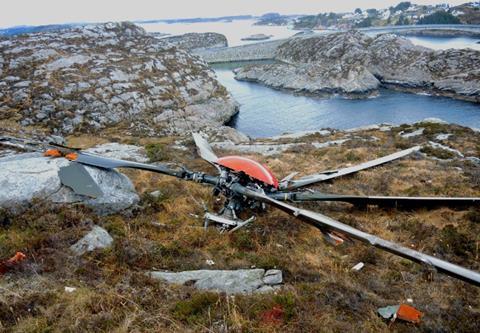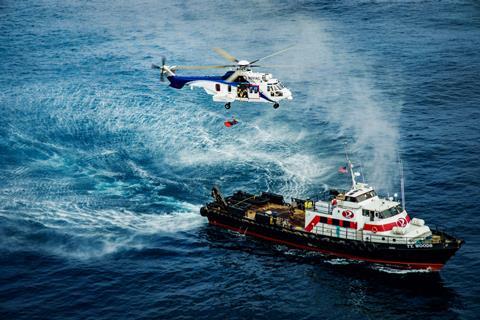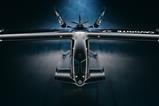Airbus Helicopters continues to insist that it sees a way back into the oil and gas market for the H225 after implementing safety improvements to the heavy-twin, however, it cautions that demand from the sector is unlikely emerge much before 2030.
Previously a mainstay of the segment alongside the Sikorsky S-92, the H225 was effectively dropped from the offshore transport role following a 2016 crash in Norway in which 13 people were killed.
Investigators subsequently pinned the accident on a faulty bearing design which caused the main gearbox (MGB) to fail and lead to the separation of the rotor.

While the gearbox issue was subsequently addressed by the manufacturer, allowing the helicopter’s return to flight, the reputational damage – alongside a downturn in the oil and gas industry – meant that operators were content to cope with only a single heavy type in service.
Despite its absence from the energy segment, the Super Puma has continued to sell, with Airbus Helicopters making “a little bit more” than 100 deliveries over the past five years, says Michel Macia, head of the H225 programme.
He expects the pace of production to be maintained over the next five years as well, based on “a good dynamic in the market for heavy aircraft”. Backlog for the type is dominated by either military or governmental-support roles, although that figure did not grow in 2023 when no orders were registered for the H225.
But a rebounding oil and gas industry and availability challenges with the S-92 – ironically driven by a shortage of gearboxes – have Airbus Helicopters reassessing the H225’s potential interest to the offshore market.
“With the difficulties the S-92 may have, we may be, for heavy aircraft, the only solution in the market, or at least we want to be the alternative solution,” says Macia.
Regis Magnac, head of energy segment at Airbus Helicopters, says the company has begun briefing the sector on the changes it has made to the aircraft, including the introduction last year of what it calls the enhanced main gearbox, or eMGB.
“We have started to do things. We are in conversation with people who are interested in the product,” says Magnac. That has included holding briefings with workforce unions in Norway, he adds.
He says it has not been a “hard sell” to get the message across. “Those people are engineers…and can understand what we have done and the energy we have put into the work to improve the aircraft, and make changes, and to understand the root cause of what happened.”
Magnac declines to say if sales talks are under way with operators, however: “We are explaining what we did, and we are talking to operators about the improvements we made and we will see where it goes.” Around 20 offshore-roled examples remain in service, he adds, chiefly in China and Vietnam.
Regardless of the industry’s appetite or otherwise for the H225, sales are unlikely to materialise in the short term. Magnac says “right now the conversations in the business are on super-mediums” like the company’s H175 and the AW189 from rival Leonardo Helicopters.
Nonetheless, he insists there will always be a requirement for heavy helicopters to handle the long-range or higher-capacity missions the super-mediums cannot perform.
“There are areas of the world where long-distance flights, potentially with de-icing are still needed, and there will be a need for replacement of the heavies flying there.”

With the youngest S-92s only reaching the 20-year mark in 2032 or 2033, interest in brand-new heavies will only begin to crystalise “in the 2030 horizon”, he thinks. “That is why the conversation needs to take place to explain what we have done so that people have in mind that there is still a product out there.”
Production is likely to remain active until 2040, he adds. “It fits well into future needs.”
However, the airframer is still likely to face an uphill struggle. ”We do not see the H225 coming back into operations in the offshore regions that we service,” says one major North Sea operator.
Key to the H225’s rehabilitation is the introduction of the eMGB and additional safety features related to the part, including systems “to monitor what is happening inside” the component, says Macia.
The eMGB and associated in-flight monitoring system is being installed on all new-build H225s and will be progressively retrofitted to the in-service fleet during scheduled overhauls.
But the pace of that retrofit roll-out will be in part dictated by operators. Although the eMGB is simply swapped in during the overhaul process, the monitoring system still needs to be installed on the aircraft.
“We are explaining to the customer what are the benefits and why they need to implement [such a system] but the speed [of the roll-out] will be more on the customer side.”
Additional steps are in the pipeline to add further “safety barriers” to the component, including an improved metallic chip detection system for ground inspections.
“What we have been working on is assessing the level of risk [that] an event could happen and each time we do not have enough safety barriers we put in additional safety barriers.”
That has included changes to the way the dynamic components are transported, ensuring no damage can take place while in transit, and addressing human factors risks during maintenance through improved processes and tooling.
So far, the process has covered about 60% of the around 250 maintenance tasks “and in two years we will have finished the job”, he adds.

“’Never again’ is really our motto inside the team,” he adds, noting that the eMGB “goes beyond the certification requirement”.
One of the safety steps that allowed the H225 to return to flight was to drop one of the MGB’s two bearing designs, and its supplier. That single-source policy has been maintained for the moment, but Macia notes that it was less an issue with a supplier and more “the specification of the bearing”.
“We have basically eliminated from the entire range of helicopters load levels higher than the new standard,” Magnac.
In the meantime, the airframer has been overhauling the design and production system for the H225, including the digitalisation of documents and creation of digital 3D models.
Simplification of the maintenance plan has also taken place, reducing the maintenance man-hours required per flight hour by -10% “and there are another bunch of reductions in process”, says Macia.
Other changes have also been made to the aircraft, updating the cockpit screens and pilot interface, and increased maximum take-off weight by 160kg.
“What we want is for this aircraft to be in flight beyond 2040 – we are not investing for just one year or even 10 years,” says Macia.
If the H225 does re-enter the offshore segment some minor changes will required to respond to regulations that have evolved in the type’s absence. But Macia says its “first assessment” is that these are not major. However, the airframer is assessing potential customer interest in order to justify any further investment.































